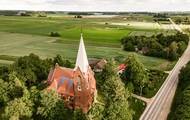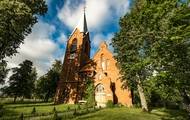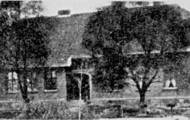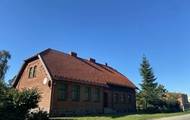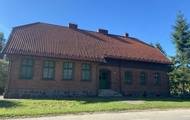The etymology of the settlement’s name is related to the formerly uncultivated lands in the surrounding area. In the mid. 20th c., when Plikiai was connected to a paved road, there were already 22 homesteads. In the early 20th c. Plikiai, Klemiškė and Klaipėda were connected by a narrow-gauge railway. The railway, referred to as kleibonių by the locals (from the German kleinbahn – narrow-gauge railway), was built between the school and the Evangelical-Lutheran church, built in 1896. Reiffeisen office, located near the railway station, used to buy grain and engage in mineral fertiliser trade. The railway station has not survived to our day. It used to be located on the north-western corner of the modern-day intersection of Gluosnio, Bažnyčios and Klaipėdos streets.
The coordinates of the object: 55.7879898, 21.2823036
Plikiai Evangelical Lutheran Church
In the first half of the 20th c. Plikiai surroundings were inhabited by a number of Catholics. However, in 1923, when Lithuania regained Klaipėda region, Plikiai had no Catholic church with red-brick Plikiai Evangelical Lutheran Church the only one in the area. That is why, in 1932, the priest and cannon Adalbertas Danelaudzkis and his parish members initiated the construction of the modern-day church with a single belfry. It successfully survived the war. The modest church of the Holy Family in Plikiai represents the architectural traditions, prevailing in the early 20th c. pre-war towns and villages in Lithuania. The top of the belfry is equipped with an old bell, cast back in 1870. This church has been included into the Register of Immovable Cultural Properties.
The coordinates of the object: 55.788206, 21.28264
Plikiai School
Plikiai school was established in 1890 with an increasing number of the population in Plikiai and the surrounding area. The school was established in a residential house, which belonged to a farmer. The second teacher was appointed to work at the school in 1902, when the population increased even more. In 1911, the teacher of the school was Emilis Hermanas Schützleris, a graduate of Karalene Teacher Seminary. In 1929, Plikiai school was attended by 77 pupils, including 59 Prussian Lithuanians and 18 Germans. In 1937, the number of pupils was 52, in 1938 – 44, including 15 local residents and 29 pupils.


_Plikiu_ev._liuteronu_baznycia_1925-1935_m..png)
_Plikiu_ev._liuteronu_baznycia_1920-1940_m._002.png)
